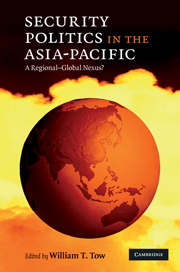Book contents
- Frontmatter
- Contents
- List of illustrations
- About the contributors
- Preface
- Acknowledgements
- List of abbreviations
- 1 Setting the context
- Part I
- 2 Grappling with an elusive concept
- 3 Asia-Pacific institutions
- 4 The United States: regional strategies and global commitments
- 5 A rising China and American perturbations
- Part II
- Part III
- Part IV
- References
- Index
3 - Asia-Pacific institutions
Published online by Cambridge University Press: 05 June 2012
- Frontmatter
- Contents
- List of illustrations
- About the contributors
- Preface
- Acknowledgements
- List of abbreviations
- 1 Setting the context
- Part I
- 2 Grappling with an elusive concept
- 3 Asia-Pacific institutions
- 4 The United States: regional strategies and global commitments
- 5 A rising China and American perturbations
- Part II
- Part III
- Part IV
- References
- Index
Summary
As Asia's great powers – China, India, Japan, Russia and perhaps Iran – assert their prerogatives over the next decades, they will reshape the global order in their interactions with each other and with the United States. Whether this next evolution in the polarity of the international system can be mediated within existing institutions is a key question. Global institutions such as the United Nations (UN) helped to mediate transitions from wartime multipolarity to Cold War bipolarity and then to post-Cold War unipolarity, but at a cost of declining relevance as councils in which the great powers resolved their conflicts or found common ground on the compelling issues of the day.
The multilateral era, dating from the end of the Second World War, holds two key and countervailing lessons for thinking about the polarity mediation capacities of international institutions. Over the course of half a century of polarity transitions, it has proved extraordinarily difficult to reform the decision-making systems of major institutions to reflect power shifts. But this has not affected the endurance of these institutions, which by and large have persisted despite the declining relevance of their representational structures. The continued construction of multilateral fora, both regional and global, partly reflects calculations that it is easier to set up new bodies than to reform or scrap existing ones. But this is not a perennial solution, because as the international stage becomes increasingly cluttered with institutions, there is less and less room for new inventions.
- Type
- Chapter
- Information
- Security Politics in the Asia-PacificA Regional-Global Nexus?, pp. 49 - 66Publisher: Cambridge University PressPrint publication year: 2009
- 4
- Cited by



